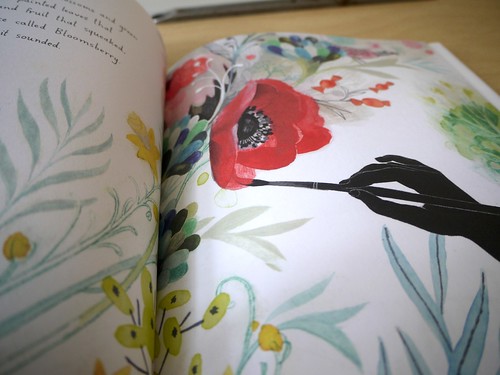
Vanessa’s sister Virginia wakes up one day feeling wolfish. Everything bothers her, she won’t talk to anyone, and she just wants to be alone, under the covers, in bed. Vanessa wants to cheer her up, but isn’t sure how. She tries just keeping Virginia company, cloud-watching with her, and maybe that helps, but Virginia still doesn’t want to talk to anyone. “If I were flying right now I might feel better,” Virginia eventually says, and when pressed says she would go to a place with “no doldrums,” a place called “Bloomsberry.” Vanessa can’t find Bloomsberry in the atlas, but that’s not a problem: she’s an artist, after all, so she can paint it and draw it and construct it from cut paper. And she does, and it helps: by the end of the book, Virginia’s back to girlish rather than wolfish.
The story, as you can presumably tell from the above, is “loosely inspired by the great writer Virginia Woolf and her older sister, painter Vanessa Bell,” as the flap copy puts it. Which is kind of great and also kind of weird: as an adult reader, knowing that Woolf was depressed and ultimately killed herself, the picture-book story of a girl/wolf stuck in the doldrums and her sister trying to comfort her sits sort of uncomfortably: it could almost seem to be equating depression with a passing sadness. But I don’t really think it is—I think it’s just that, in a picture book, it’s probably best to stick to passing sadness/a bad mood, which anyone can relate to. I mean, depressed people can be ordinary-sad and ordinary-grumpy too. And I like the way the story emphasizes art and creation as a way to make a bad mood better: it’s Vanessa’s art, and Virginia’s engagement in it/assistance with it, that improves things; after helping Vanessa with the paper birds and butterflies, Virginia even engages in some art-making of her own, telling Vanessa “a story about a gray-shelled snail that passed along the earth and reached the top of a mountain without realizing it.”
But the story (which is by Maclear) isn’t the highlight of the book for me—the art (by Arsenault) is. Arsenault works in ink, pencil, watercolor, and gouache, and her work matches the mood of the book wonderfully. For the spreads showing Virginia’s wolfish bad mood there are lots of blues and greys and shadows; Virginia, as wolf, is shown as a smudgy pencil drawing, dark and wild in contrast to Vanessa with her pink cheeks and yellow dress and yellow hair bow. As Virginia retreats under the covers, the color palate diminishes to almost only and grey and black and shadow, even for Vanessa. But then there’s Vanessa’s art, the first spread of which is shown in the picture above: there are yellows and greens and blues and pinks, and the beautiful red of that poppy. Reds and pinks feature heavily in the next two spreads, and then comes one of black and flecks of pale blue on a yellow ground, which is a perfect inversion (in color and in art and in text, too) of an earlier spread that was pale grey-blue and black with yellow specks. (It works thematically: the first spread is about how with Virginia’s sorrow “the whole house sank” and “up became down.” The later spread is about how “the whole house lifted.”) It’s really lovely.
Leave a Reply